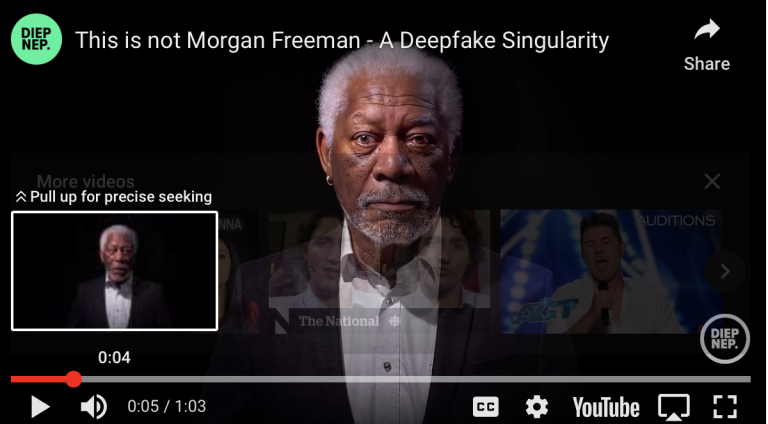



"We’re giving people on Facebook and Instagram even more power to control the algorithm that ranks posts in their Feed."
YouTube
"The platform is trying to balance limiting the spread of potentially harmful misinformation with the need to allow discussion and education about sensitive and controversial topics."


Detecting Misinformation
I saw a photo several weeks ago that was heart wrenching. It depicted an ash covered father emerging from the rubble of a bombed out building in Gaza. He was carrying four small children and leading a fifth by the hand. The children were traumatized and bewildered. The caption stated that this is what it was like to be a father in Gaza. The implication of course was that the Israeli’s were cruel and merciless in their bombing of innocent civilians. The number of children reported dead has surpassed the annual number of child deaths in any other world conflict since 2019. Notice that this report came from Ramallah home to the Palestinian Authority. https://www.savethechildren.net/news/gaza-3195-children-killed-three-weeks-surpasses-annual-number-children-killed-conflict-zones
I have learned several way to check the authenticity of these stories. On method in particular I find very helpful. It can be called Lateral Reading or another name is the acronym SIFT, which stands for Stop, Investigate, Find Coverage & Trace Claims. Whenever we view a news site or see any sensational story, rather than just scroll down the page, we should make some lateral readings. Stop before becoming emotional involved or invested and investigate the sources. Search out other agencies that may have covered the same story and see how they reported it. Then trace the claims made by the original source. We can investigate the source on Wikipedia as well.
A fact checking organization called BOOM, https://www.boomlive.in/, found the image to be AI generated with several telltale signs such as extra limbs and misshapen limbs.
Likewise the image, when put through AI image detector tools AIOrNot.com and Hive Moderator https://hivemoderation.com/ai-generated-content-detection, both suggested that the image was likely generated by AI.
This image was used by Facebook users and received tens of thousands of views. It is one small part of the vortex of culture wars and online disinformation. We are seeing increasing of people in America, most notable the younger generations, relying on the web for the full content of their political awareness. There are many players who are only too willing to generate false scenarios an AI generated photos to feed that awareness and channel the resulting anger.
We are seeing an explosion of online news sources, many of which are located in someones basement. If the finished product is slick with sharp video and convincing backgrounds, we believe the content without checking to see if it is true. However now more than ever we must check the facts of any story by any news outlet, mainstream or otherwise.
I am glad that there are online resources for detecting manipulated news accounts. But it is ultimately up to us to use these sources and check for ourselves. As one past president once said, “trust but verify”.
With the advent of new generations of AI we can only expect more and more “generated” news stories meant to sway public opinion with a cll to take action. The perpetrators are getting better, but so are the fact checking sites and organizations. We do not have to be duped. We can SIFT through the stories, posts and memes to find the truth or even to discover the lie.
Controlling Disinformation
Instagram is a social media program that I use and enjoy more than most others. I like staying in touch with friends from around the world as well as seeing the wonder photography displayed in the posts. I do not gather my news from this platform and I stay away from political posts, however I know that they exist on the platform. I was pleased to see that Meta, the owner of Instagram, recently introduced features to reduce misinformation. https://www.nbcnews.com/tech/social-media/instagram-censor-fact-check-option-setting-ig-palestine-palestinian-rcna129484
NBC News reports that a new feature on Instagram allows users to control the “fact check control program”. A Meta spokesperson stated, "We’re giving people on Facebook and Instagram even more power to control the algorithm that ranks posts in their Feed. If someone wants to adjust the demotions on fact-checked content in their Feed, they must change the setting on their own. We’re doing this in response to users telling us that they want a greater ability to decide what they see on our apps.”
However there has been a backlash from some who believe that the feature is politically motivated toward some groups. Personally I like the fact that this feature gives me more control over the fact checking of my content. And I know for a fact as I stated in my last blog update, some of the groups who feel they are targeted are actually groups that spread misinformation on a wide scale.
Instagram itself explains the new feature like this. “When third-party fact checkers identify false information, altered content or content with missing context on Instagram, we may make it harder to find by filtering it from Explore and Hashtags, and reducing its visibility in Feed and Stories.” https://help.instagram.com/388534952086572
I think this is a positive step in reducing the level of misinformation deliberately released online and I welcome the personal control.
The second platform that I visit frequently is YouTube. I enjoy both entertainment as well as learning from this platform. I sometimes also gather news from various news sources both here in the USA as well as abroad. I enjoy viewing video posts from a variety of countries.
Recently, a group of 80 fact checking groups took YouTube to task for not policing its video content. They accuse the platform of knowingly allowing misleading content posted by conspiracy groups and others. The signers urges the platform to make four changes: To fund independent research into disinformation on the channel, provide links to rebuttals within the videos suspected of disinformation, changing the algorithm so it stops repeat offenders and do more to stop non English videos promoting falsehoods. https://www.theguardian.com/technology/2022/jan/12/youtube-is-major-conduit-of-fake-news-factcheckers-say
I find the assertion of the 80 signers to be offensive. I believe in a free speech platform that does not need to be policed by special interest groups posing as “fact police”. The public that views the channels on YouTube bear the responsibility to ascertain what is truth and what is error. We must maintain a platform where all sides are expressed to be either disregarded or accepted by the viewers.
C-net reports that “Stopping misinformation before it goes viral is now a top goal for YouTube”. https://www.cnet.com/news/social-media/youtube-eyes-new-ways-to-stop-misinformation-from-spreading-beyond-its-reach/ In this article C-net quotes Neal Mohan, YouTube’s Chief Product Officer, as saying that the platform is trying to balance limiting the spread of potentially harmful misinformation with the need to allow discussion and education about sensitive and controversial topics.
To me the operative word in that statement is “potentially”. Who determines what is potentially harmful? Who is the arbiter of truth? I see the two sides of our political spectrum with their own sets of standards by which they judge and evaluate information. Every bit of information is potentially harmful to one side or the other. To mitigate the harm to a position, the information is labeled as harmful disinformation even if it happens to be true. If it strays from the party policy, it must be stopped or at least doubted.
I believe that the measures being taken by the social media platforms are sufficient. I am not swayed by disinformation when I am aware of it, I simply delete it. Everyone has the same ability to discern and delete. I am alarmed at how controlled some want our social media. It should remain a free platform for the dissemination and discussion of every opinion whether we agree with it or not. I believe political propaganda is far more dangerous and throughout history it has not depended on social media platforms.
The Danger of Deep Fakes
Educators Tips for Instruction
As educators our first responsibility is to our students. We are called upon to give them the tools they need for critical thinking as well as prepare them for a rapidly changing world. Artificial Intelligence or AI is changing the digital world at a rapid pace. We now have the creation of “synthetic media” which is posted on social media platforms as disinformation. Some of this is by “deep fakes”, when images are altered by AI to resemble an actual person. This technology can be used for weaponizing social media and spread disinformation by a seemingly trusted source.
“Today, the technology utilized to produce a convincing face swap involves AI. The technology allows an adversary to swap the face of one person onto another person’s face and body.”
https://www.dhs.gov/sites/default/files/publications/increasing_threats_of_deepfake_identities_0.pdf
An example of the sophistication of this process depicts Morgan Freeman. He warns us about the danger of deep fakes in the following video. This is not Morgan Freeman but an AI deep fake copy of him. As we can see, the image and video is believable at first glance. However there are telltale signs to look for. What we need to teach our children is how to recognize a deep fake so they will not be influenced by dangerous disinformation. Here are some warning signs:
- Blurred or fuzzy borders of the person
- Strange or misplaced shadows
- Uneven or inconsistent skin tones
- Abnormal blinking patterns
- Robotic or non-human vocal patterns
https://www.linkedin.com/pulse/how-talk-deepfakes-your-child-barktechnologies-rg1vf
©Copyright. All rights reserved.
We need your consent to load the translations
We use a third-party service to translate the website content that may collect data about your activity. Please review the details in the privacy policy and accept the service to view the translations.


